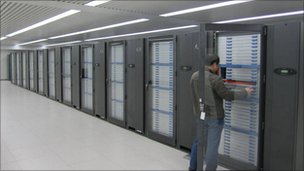Molawchai
BANNED

- Joined
- May 30, 2010
- Messages
- 290
- Reaction score
- 0
BBC News - China claims supercomputer crown 28 October 2010

The Tianhe-1A supercomputer is about 50% faster than its closest rival.
China has claimed the top spot on the list of the world's supercomputers.
The title has gone to China's Tianhe-1A supercomputer that is capable of carrying out more than 2.5 thousand trillion calculations a second.
To reach such high speeds the machine draws on more than 7,000 graphics processors and 14,000 Intel chips.
The claim to be the fastest machine on the planet has been ratified by the Top 500 Organisation which maintains a list of the most powerful machines.
High power
China's Tianhe-1A (Milky Way) has taken over the top spot from America's XT5 Jaguar at the Oak Ridge National Laboratory (ORNL) in Tennessee that can carry out only 1.75 petaflops per second. One petaflop is the equivalent of 1,000 trillion calculations per second.
The news about the machine broke just before the publication of the biennial Top 500 Supercomputer list which ranks the world's most powerful machines.
Prof Jack Dongarra from the University of Tennessee, one of the computer scientists who helps to compile the list, said China's claim was legitimate.
"This is all true," he told BBC News. "I was in China last week and talked with the designers, saw the system, and verified the results."
He added: "I would say it's 47% faster than the Oak Ridge National Laboratory's machine, 1.7 Pflops (ORNL system) to 2.5 Pflops (Chinese system)."
Tianhe-1A is unusual in that it unites thousands of Intel processors with thousands of graphics cards made by Nvidia.
The chips inside graphics cards are typically made up of small arithmetical units that can carry out simple sums very quickly. By contrast, Intel chips are typically used to carry out more complicated mathematical operations.
The machine houses its processors in more than 100 fridge-sized cabinets and together these weigh more than 155 tonnes.
Based in China's National Center for Supercomputing in the city of Tianjin, the computer has already started to do work for the local weather service and the National Offshore Oil Corporation.

The Tianhe-1A supercomputer is about 50% faster than its closest rival.
China has claimed the top spot on the list of the world's supercomputers.
The title has gone to China's Tianhe-1A supercomputer that is capable of carrying out more than 2.5 thousand trillion calculations a second.
To reach such high speeds the machine draws on more than 7,000 graphics processors and 14,000 Intel chips.
The claim to be the fastest machine on the planet has been ratified by the Top 500 Organisation which maintains a list of the most powerful machines.
High power
China's Tianhe-1A (Milky Way) has taken over the top spot from America's XT5 Jaguar at the Oak Ridge National Laboratory (ORNL) in Tennessee that can carry out only 1.75 petaflops per second. One petaflop is the equivalent of 1,000 trillion calculations per second.
The news about the machine broke just before the publication of the biennial Top 500 Supercomputer list which ranks the world's most powerful machines.
Prof Jack Dongarra from the University of Tennessee, one of the computer scientists who helps to compile the list, said China's claim was legitimate.
"This is all true," he told BBC News. "I was in China last week and talked with the designers, saw the system, and verified the results."
He added: "I would say it's 47% faster than the Oak Ridge National Laboratory's machine, 1.7 Pflops (ORNL system) to 2.5 Pflops (Chinese system)."
Tianhe-1A is unusual in that it unites thousands of Intel processors with thousands of graphics cards made by Nvidia.
The chips inside graphics cards are typically made up of small arithmetical units that can carry out simple sums very quickly. By contrast, Intel chips are typically used to carry out more complicated mathematical operations.
The machine houses its processors in more than 100 fridge-sized cabinets and together these weigh more than 155 tonnes.
Based in China's National Center for Supercomputing in the city of Tianjin, the computer has already started to do work for the local weather service and the National Offshore Oil Corporation.


 ) and infrastructure sector (
) and infrastructure sector (






